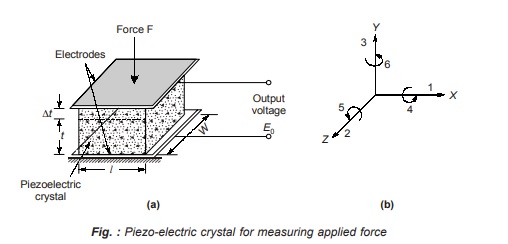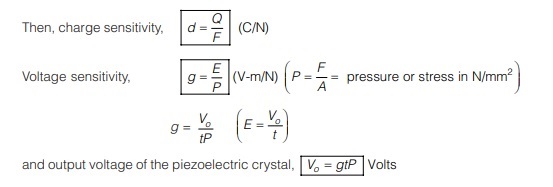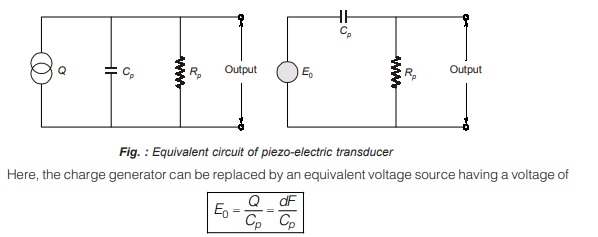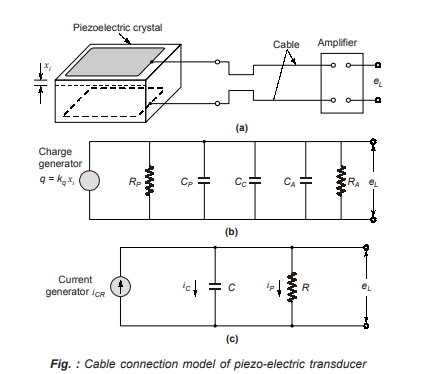Piezo Electric Transducers
When a varying potential applied to the proper axis of a crystal, there is a change in dimension of the crystal which is known as “Piezo-electric effect”. The reverse effect is also true, i.e., if the dimensions of the crystal are changed by the application of a mechanical force, an electric potential appears across certain surface of the crystal due to the displacement of charges. The elements which exhibit piezo-electric qualities are called as “Electro-resistive elements”.
Below figure describes the phenomena of piezo-electric effect on a piezo-electric crystal with the application of a force, F

Classification of Piezo-Electric Materials:
(i) Natural Group: Natural group include quartz and rochelle salt
(ii) Synthetic Group: Synthetic group include materials like Lithium Sulphate, Ethylene Diamine Tartarate,
Potassium Dihydrogen Phosphate, Barium Titanate, Ammonium Dihydrogen Phosphate, Lead Zirconate, etc.
All piezo-electric materials are electrical insulators.
1. Piezo-electric effect is direction sensitive. A tensile force produces a voltage of one polarity while a compressive force produces a voltage of opposite polarity.
2. Two metal electrodes are placed on each side of the material to bring out the charge. Hence, a piezo-electric material is equivalent to a charge generator and a capacitor.
3. Let the applied force on the piezo-electric crystal be F.
Q = charge
t = thickness of the crystal
E = electric field intensity
P = pressure applied
g = voltage sensitivity of the crystal
Q ∝ F
Q = dF

![]()
4. Piezoelectric transducers are suitable for dynamic pressure or force measurement.
5. For static inputs, the internal charges fastly discharges and hence the output becomes zero.
6. Equivalent Circuit of Piezo-electric Transducers:
Below figure shows an equivalent circuit of a piezo-electric transducer

7. Piezo-electric transducers are mainly used for measurement of displacement. They can be used for measurement of force, pressure or acceleration. These quantities when measured with piezo-electric transducers are first converted into displacement and the displacement is then, applied to these transducers to produce an output voltage.
8. Cable Connection Model of Piezo-electric Transducers:
Below figure shows the cable connection model of piezo-electric transducer. It shows the transducer, the connecting cable and the amplifier as a unit. The impedance of the transducer is very high and hence an amplifier with a high input impedance has to be used in order to avoid loading effect.

Here,
Rp = Leakage resistance of transducer
Cp = Capacitance of transducer
Cc = Cable capacitance
CA = Amplifier capacitance
RA = Amplifier resistance

9. Properties of Piezo-Electrica Crystals:
The desirable properties of piezo-electric materials are stability, high output insensitivity to temperature and humidity and the ability to be formed into most desirable shape. Quartz is the most stable piezo-electric material. However, its output is quite small. On the other hand Rochelle salt provides the highest output but it can be worked over a limited humidity range and has to be protected against moisture.
Barium titanate has the advantage that it can be formed into variety of shapes and sizes since it is polycrystalline. It also has a higher dielectric constant.
Natural crystals possess higher mechanical and thermal stability, can withstand higher stresses, have low leakage and have a good frequency response. The synthetic materials, in general have a higher voltage sensitivity.
| Material | Voltage sensitivity (g) | Permittivity (e) | Charge sensitivity (d) |
|---|---|---|---|
|
Barium titanate |
12 × 10–3 | 12.5 × 10–9 |
150 |
| Quartz | 50 × 10–3 | 40.6 × 10–12 |
2 |
Advantage of Piezo-electric Transducers
- It’s input impedance is high. So, loading effect is minimum
- Good dynamic response
- Compact in size
Disadvantage of Piezo-electric Transducers
Lack of steady state response.
- The use of piezo-electric transducers is confined primarily to dynamic as the voltage developed by application of strain is not held under static conditions. Hence, the elements are primarily used in the measurement of such quantities as surface roughness and in accelerometers and vibration pickups.
- Ultrasonic generator elements also use barium titanate, a piezo-electric material. Such elements are used in industrial cleansing apparatus and also in underwater detection system known as sonar.
Advantages of Instrument Transformers
Instrument transformers are widely used for the precise and routine measurement of voltage and current because of the following advantages:
- Several instruments can be operated from a single instrument transformer (CT or PT).
- The measuring circuit is isolated from the high voltage power-circuit which ensures safety of the operator.
- There is low power consumption in the measuring circuit.
- The replacement of instrument transformer is easier.
- Instrument transformers are used for the measurement of large magnitude of current and voltages.
- Instrument transformers produce practically the same instrument reading regardless of the constants of the instruments.
- Instrument transformers helps in reducing overall cost, since various instruments including metering, relaying, diagnostic etc. can all be connected to the same instrument transformer
<< Previous | Next >>
Must Read: What are the Electrical and Electronics Measurements?

